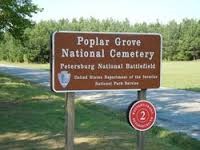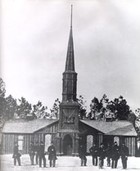Poplar Grove National Cemetery
Introduction
Text-to-speech Audio
Images
Entrance sign to the cemetery.

The luminary event at Poplar Grove National Cemetery.

Late 1800s photo of the Poplar Grove Church, the cemetery's namesake

Union burial party at Poplar Grove after the occupation of Petersburg

Fresh graves at Poplar Grove

Ariel view of part of the cemetery

Backstory and Context
Text-to-speech Audio
In 1866, Colonel James Moore set out to find land in Petersburg for a final resting place to become a National Cemetery because during times of war it becomes extremely difficult for soldiers who are killed in battle to have a proper burial. He found a place on a farm just outside the city. However, this meant that many soldiers already buried in mass graves needed to be exhumed. Many soldiers who were buried in the cemetery were unidentified but they were still given the same funerary rites for their time in service.
The tenuous task of relocating the bodies took approximately three years to accomplish. About 100 men, their horses and mules, and their wagons took on the grueling task of searching the area of the battlefield for grave sites. When a body was found, the men removed the soldiers and placed them into wooden coffins to be properly recognized in the National Cemetery.
The park is one of fourteen National Cemeteries overseen by the National Park Service. It is closed to burials but visitors are welcome to visit the site for memorials or reflection. The park's visitor center has more information on finding the names of the known soldiers who are buried here.
